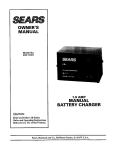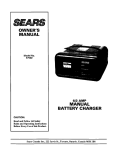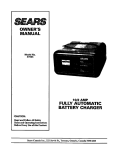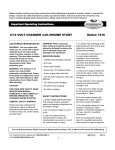Download Sears 200.71219 Owner`s manual
Transcript
OWNER’S MANUAL ® Battery Charger/Maintainer 2 Amp, 12 Volt 4 Amp, 6 Volt Fully Automatic with Float-Mode Monitoring Model No. 200.71219 CAUTION: Read and follow all Safety Rules and Operating Instructions Before Every Use of this Product. Save these instructions. Sears, Roebuck and Co., Hoffman Estates, IL 60179 U.S.A. 0099000589/1205 TABLE OF CONTENTS WARRANTY................................................................................................................. 2 IMPORTANT SAFETY INSTRUCTIONS .................................................................... 3 PERSONAL SAFETY PRECAUTIONS ...................................................................... 4 BEFORE USING YOUR BATTERY CHARGER ......................................................... 5 Plugging It In.......................................................................................................... 5 Using An Extension Cord....................................................................................... 5 50 Amp Battery Clamps......................................................................................... 5 Permanent Ring Connectors.................................................................................. 5 12V Accessory Plug............................................................................................... 5 USING YOUR BATTERY CHARGER.......................................................................... 6 PREPARING YOUR BATTERY TO BE CHARGED ................................................... 6 OPERATING INSTRUCTIONS ................................................................................... 7 Charging Battery In The Vehicle............................................................................. 7 Charging Battery Removed From The Vehicle....................................................... 8 BATTERY PERCENT AND CHARGE TIME................................................................ 9 MAINTENANCE AND CARE ...................................................................................... 9 TROUBLESHOOTING................................................................................................ 10 SAVE THIS OWNER’S MANUAL AND READ BEFORE EACH USE. The 71219 Fully Automatic Battery Charger/Maintainer offers features to accommodate the needs for home or light commercial use. This manual will show you how to use your charger safely and effectively. Please read and follow these instructions and precautions carefully. For information about troubleshooting, call toll-free from anywhere in the U.S.A. 7 am to 4:30 pm Central Time Monday through Friday. 1-800-SEARS-64 (1-800-732-7764). WARRANTY THREE-YEAR FULL warranty If this Battery Charger 71219 fails due to a defect in materials or workmanship within 3 years from the date of purchase, RETURN IT TO ANY SEARS STORE or OTHER DIEHARD OUTLET IN THE UNITED STATES FOR FREE REPLACEMENT. This warranty gives you specific legal rights, and you may also have other rights which vary from state to state. Sears, Roebuck and Co., Dept. 817WA, Hoffman Estates, IL 60179 Important Safety Instructions WARNING – RISK OF EXPLOSIVE GASES WORKING IN VICINITY OF A LEAD-ACID BATTERY IS DANGEROUS. BATTERIES GENERATE EXPLOSIVE GASES DURING NORMAL BATTERY OPERATION. FOR THIS REASON, IT IS OF UTMOST IMPORTANCE THAT EACH TIME BEFORE USING YOUR CHARGER, YOU READ THIS MANUAL AND FOLLOW THE INSTRUCTIONS EXACTLY. To reduce risk of battery explosion, follow these instructions and those published by battery manufacturer and manufacturer of any equipment you intend to use in vicinity of battery. Review cautionary markings on these products and on engine. save these Instructions • WARNING: Battery chargers get hot during operation and must have proper ventilation. Air needs to flow around entire charger. Do not set charger on flammable materials like carpeting, upholstery, paper, cardboard, etc. Charger may damage leather, plastic and rubber. This manual contains important safety and operating instructions for battery charger Model 71219. • Read all instructions and cautions printed on the battery charger, battery, and vehicle or equipment using battery. • Use charger only on lead-acid type rechargeable batteries, such as those used in motorcycles, lawn tractors, ATVs, RVs, boats, snowmobiles antique and classic cars. This charger is not intended to supply power to a low voltage electrical system other than in a starter-motor application. Help us help you —— Remember: Place charger as far away from the battery being charged as the charger cables will permit. Do not expose charger to rain or snow. Never charge a frozen battery. If battery fluid (electrolyte) becomes frozen, bring battery into a warm area to allow battery to thaw before you begin charging. • Never use charger for charging dry cell batteries that are commonly used with home appliances like radios, stereos, remote controls, etc. These batteries may burst and cause personal injury. Never allow battery acid to drip on charger when reading specific gravity or filling battery. • Do not disassemble charger. Take it to a qualified service professional if service or repair is required. Incorrect assembly may result in fire or electrical shock. Never set a battery on top of charger. Never place charger directly above battery being charged. The gases from the battery will corrode and damage the charger. • To reduce risk of electrical shock, unplug the charger from the 110V AC electrical wall outlet before attempting any maintenance or cleaning. Never touch the battery clamps together when the charger is on. You could cause a spark. • Always charge battery in a well-ventilated area. Never operate charger if it has received a hard blow, been dropped, or otherwise damaged. Take it to a qualified professional for inspection and repair. Do not operate the charger if it has a damaged power cord or plug. Have the cord replaced. Connect and disconnect DC clamps only after removing charger AC power cord from the wall outlet. Do not permit clamps to touch each other. Be sure to position the charger power cord to prevent it from being stepped on, tripped over, or damaged. Never pull out the plug by the cord when unplugging the charger. Pulling on the cord may cause damage to the cord or the plug. Personal Safety Precautions • Wear complete eye and clothing protection when working with leadacid batteries. working with a lead-acid battery. A battery can produce a short circuit current high enough to weld a ring (or the like) to metal, causing a severe burn. • Make sure that someone is within range of your voice to come to your aid if needed while you work with or are near a lead-acid battery. • Take care not to drop any metal tool or metal object onto the battery. This may result in a spark or short circuit across the battery or another electrical device that may cause an explosion. • Have plenty of fresh water and soap nearby for use in case battery acid contacts your eyes, skin, or clothing. If this happens, wash immediately with soap and water. Then get medical attention. • Always operate the battery charger in an open, well-ventilated area. • Avoid touching your eyes while working with a battery. Wear safety glasses. Acid particles (corrosion) may get into your eyes. If this occurs, flush eyes immediately with running cold water for at least 15 minutes. Then immediately get medical attention. • Never smoke or allow a spark or flame in the vicinity of the battery or engine. Batteries generate explosive gases. • Neutralize any acid spills thoroughly with baking soda before attempting to clean up. • If necessary to remove battery from vehicle to charge, always remove grounded terminal from the battery first. Make sure all accessories in the vehicle are off, so as not to cause an arc. • Use the charger for charging a leadacid battery only. It is not intended to supply power to a low-voltage electrical system other than in an automotive application. Do not use battery charger for charging dry cell batteries that are commonly used with home appliances. These batteries may burst and cause injury to persons or damage to property. • WARNING: Handling the cord on this product or cords associated with accessories sold with this product, may expose you to lead, a chemical known to the State of California to cause cancer and birth defects or other reproductive harm. Wash hands after handling. • Remove all personal metal items from your body such as rings, bracelets, necklaces and watches, while BEFORE USING YOUR BATTERY CHARGER It is important to understand the charger’s requirements. This section explains the charger’s electrical requirements and how to prepare a battery for charging. PLUGGING IT IN Your charger requires a 120V AC electrical outlet installed according to all local codes and ordinances. Permanent Ring Connectors The ring connectors permanently attach to the battery providing easy access to quickly charge your battery. This application is appropriate for motorcycles, lawn tractors, ATVs and snowmobiles. To permanently attach to a battery, loosen and remove each nut from bolts at battery terminal. Connect the red POSITIVE ring connector ring to the POSITIVE battery terminal. Connect the black NEGATIVE connector ring to the NEGATIVE battery terminal. Replace and tighten the nuts to secure. Take care to keep both wires and plug away from metal and the engine hood. Plug the power cord into a 3-prong grounded 110V AC electrical wall outlet. USING AN EXTENSION CORD The use of an extension cord is not recommended. If you must use an extension cord, please make sure that you follow these guidelines: • Make sure that pins on plug of extension cord are the same number, size, and shape as those of plug on charger. • Check that the extension cord is properly wired and in good electrical condition. • Make sure that the wire size is large enough for its length and for the AC ampere rating, as specified in the chart below. 12V Accessory Plug Charge or maintain your battery without lifting the hood. MINIMUM RECOMMENDED EXTENSION CORD Length of Cord, in Feet 25 50 100 150 AWG* Size of Cord 18 18 16 14 1. C o n n e c t t h e e n d of t h e 12 V accessory plug to the matching end of the charger power cord. Make sure connection is tight. *AWG=American Wire Gauge 2. Insert the 12V accessory plug into the 12V accessory outlet. Versatile Quick-Harness Snap any of the three connectors into place in seconds: 50 amp Battery Clamps Connect the end of the charger power cord and the end of the 50 Amp Battery clamps together. Follow the Operating Instructions to connect the output clamps to the battery. After a solid electrical connection is made to the battery, plug the power cord into a 3-prong grounded 110V AC electrical wall outlet. 3. R o u t e t h e p owe r c o r d from charger through the vehicle’s open window. 4. Plug into an 110V AC electrical wall outlet. Make sure to place charger on a dry, nonflammable surface, like metal or concrete. Using Your Battery Charger The charger does not have an ON/OFF switch. The On and Off commands are controlled by plugging the 71219 into a 110V AC electrical wall outlet only after battery connections have been made. Maintain Mode: When the Charged (green) LED is lit, the charger has started Maintain Mode. This mode of operation is also known as Float-Mode Monitoring. In this mode, the charger keeps the battery fully charged by delivering a small current, when necessary. The voltage is maintained at a level determined by the 6 or 12 volt battery selected. AMP/VOLT SELECTOR SWITCH 2A, 12V AMP/VOLT SELECTOR 4A, 6V LED Indicators Charging Charged/ Maintain Mode Check Battery* Yellow Green Red *Indicates an overload condition caused by shorting of the battery clamps, reverse polarity hookup connection to a battery, or charging a problem battery. Preparing your battery to be charged It is important that you read and follow these guidelines while you are preparing to charge the battery. • Make sure that you have a 6 or 12 volt lead-acid battery. Determine voltage of battery by referring to vehicle owner’s manual. Charge battery initially at charger’s lowest rate. • Clean the battery terminals. Be careful to keep corrosion from getting in or around your eyes or on your hands. • Wear safety glasses. See additional “Personal Safety Precautions” on. page 4. • For batteries with removable vent caps, if required, add distilled water to each cell until the battery acid reaches the level recommended by the manufacturer. This will help purge excessive gases from the cells. Be careful not to overfill. If you have a sealed battery with non-removable vent caps, no action is necessary. • Take time to read all of the battery manufacturer’s specific precautions, such as removing or not removing vent caps while charging, and recommended rates of charge. • Be sure that the area around the battery is well ventilated while it is being charged. Gases emitted from the battery can be forcefully blown away by using a piece of cardboard or other nonmetallic material as a fan. • If it is necessary to remove the battery from the vehicle to charge it, always remove the grounded terminal from the battery first. Turn off all vehicle accessories to avoid sparks from occurring. DANGER - Never alter the AC plug provided. If it will not fit the outlet, have a proper outlet installed by a qualified electrician. Improper connection can result in the risk of electrical shock. WARNING ‑ Connect and disconnect the battery clamps only when the AC power cord is disconnected or arcing may result. • NOTE: A marine (boat) battery installed in a boat must be removed and charged on shore. operating instructions IMPORTANT: Follow all safety instructions and precautions when charging your battery. Wear complete eye protection and clothing protection. Charge your battery in a well-ventilated area. Charging Battery In The Vehicle: twist the clamp back and forth to be sure a solid electrical connection is made. Then connect the red (POSITIVE) output clamp to a heavy, unpainted metal part of the chassis or engine block, away from the battery. DO NOT connect clamp to positive battery post, carburetor, fuel line or sheet metal part. 1. Avoid personal injury by keeping clear of fan blades, belts, pulleys and other engine parts. 2. Avoid damaging the charger by keeping the power cord and output cords away from the hood, door or moving engine parts. 6. Select the desired charge rate and battery type: 2A, 12V or 4A, 6V. 3. Note the polarity of the battery posts by checking the identification marks on the battery: POSITIVE (POS, P or +) and NEGATIVE (NEG, N or -). The positive post is usually larger than the negative post. 7. Plug power cord into an 110V AC electrical wall outlet. 8. The CHARGING (yellow) LED should light and the charging process should start. If the CHECK (red) LED is on, check for correct cable connections. Also, the red light could mean the battery is trying to draw more current than the charger is rated for. 4. Identify which battery post is grounded or connected to the chassis. THIS IS NORMALLY THE NEGATIVE POST. 9. The charger stops charging automatically after the battery is fully charged. Charge completion is indicated by CHARGED (green) LED and the charger has automatically switches to float mode charging and switched to the Maintain Mode of operation. NEGATIVE GROUNDED SYSTEM 5. Connecting to a negative-grounded system: Connect the red (POSITIVE) output clamp to the POSITIVE post of the battery. Rock and twist the clamp back and forth to be sure a solid electrical connection is made. Then connect the black (NEGATIVE) output clamp to a heavy, unpainted metal part of the chassis or engine block, away from the battery (see figure above). DO NOT connect clamp to negative battery post, carburetor, fuel line or sheet metal part. Connecting to a positive-grounded system: Connect the black (NEGATIVE) output clamp to the NEGATIVE post of the battery. Rock and NOTE: As the battery nears the full charge state, both the yellow and green LEDs may light. The yellow LED will fade out as the green LED gets brighter. 10.To disconnect the charger, unplug the power cord from the 110V AC electrical wall outlet before attempting to disconnect the output clamps. Then, standing away from the battery, remove the output clamp from the chassis or engine block. Finally, remove the output clamp from the battery post. 11.Clean and store the charger in a dry location. Charging Battery Removed From The Vehicle: POSITIVE 4. Position yourself as far away from the battery as possible, and then connect the black (NEGATIVE) output clamp to the free end of the cable. NEGATIVE BATTERY CHARGER BATTERY 24", 6 GAUGE CABLE 5. Select the desired charge rate and battery type: 2A, 12V or 4A, 6V. 6. Plug the power cord into an AC 110V electrical wall outlet. POWER CORD 7. Press the appropriate control buttons to select the desired charge rate and battery type. The CHARGING (yellow) LED should light and the charging process should start. If the CHECK (red) LED is on, check for correct cable connections. TO GROUNDED POWER OUTLET 1. Note the polarity of the battery posts by checking the identification marks on the battery: POSITIVE (POS, P or +) and NEGATIVE (NEG, N or -). The positive post is usually larger than the negative post. 8. To disconnect the charger, unplug its power cord before attempting to disconnect the charger clamps. Then, standing away from the battery, remove the output clamp from the NEGATIVE battery post. Finally, remove the output clamp from the POSITIVE battery post. 2. Attach at least a 24-inch-long, 6gauge (AWG), insulated battery cable to NEGATIVE (NEG, N or -) battery post. Rock and twist the clamp back and forth to be sure a solid electrical connection is made. 9. Clean and store the charger in a dry location. 3. Connect the red (POSITIVE) output clamp to the POSITIVE battery post. Rock and twist the clamp back and forth to be sure a solid electrical connection is made. IMPORTANT: Follow all safety instructions and precautions when charging your battery. Wear complete eye protection and clothing protection. Charge your battery in a well-ventilated area. battery percent and charge time This charger adjusts the charging time in order to charge the battery completely, efficiently and safely. This battery charger has a rated output of 2 and 4 ampere. This output will vary with the age and condition of the battery being charged. If battery has only been slightly discharged, it can be charged in less than a few hours. The same battery will take longer to charge if it is very weak. charging times Battery Condition 2 Amp, 12 Volt Battery Ampere Hour Battery Capacity 50% Discharged 100% Discharged Approximate Average Charge Time In Hours 10 12 20 3.2 4.0 6.4 6.2 7.5 12.4 Battery Condition 4 Amp, 6 Volt Battery Ampere Hour Battery Capacity 50% Discharged 100% Discharged Approximate Average Charge Time In Hours 10 12 20 1.6 2.0 3.2 3.2 4.0 6.4 MAINTENANCE AND CARE A minimal amount of care can keep your battery charger working properly for years. 1. Clean the clamps each time you are finished charging. Avoid skin contact with battery acid. See “Personal Safety Precautions”, page 4. 2. Coil the input and output cords neatly when storing the charger. This will help prevent accidental damage to the cords and charger. Avoid skin contact with battery acid. See “Personal Safety Precautions”, page 4. 3. Occasional cleaning of the case of the charger with a soft cloth will keep the finish shiny and help prevent corrosion. 4. Store the battery charger in a clean and dry location. notes 10 notes 11





















